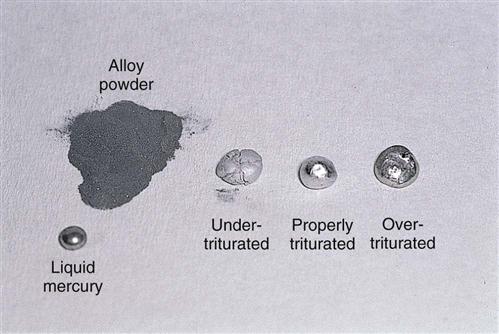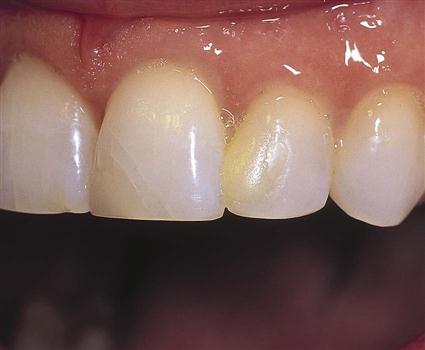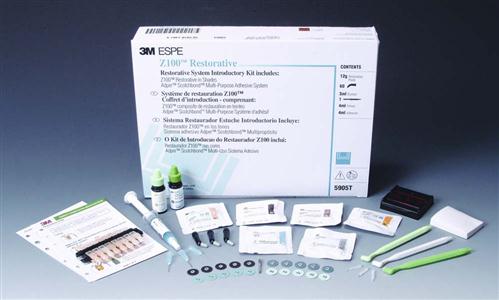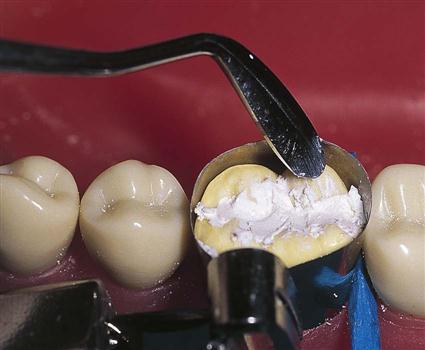Restorative Materials
Learning Objectives
1 Pronounce, define, and spell the Key Terms.
2 List the types of dental materials commonly used in restorative dentistry.
3 Describe amalgam and its importance in dentistry.
4 Describe composite resins and their importance in dentistry.
5 Describe the use of cements for restorative dentistry.
6 Describe the use of tooth-whitening products in the esthetic aspect of restorative dentistry.
Key Terms
Alloy
Amalgam
Amalgamator
Bonding
Cements
Composite Resins
Curing
Etching
Exothermic
Force
Galvanic
Pestle
Polymerize
Retention
Strain
Stress
Tooth Whitening
Trituration
The term restorative means to replace or bring something back to its natural appearance and function. The types of restorative materials selected by the general dentist are: (1) amalgam, which is the clinical name for silver fillings (this restorative material, first introduced in 1826, was perfected by G.V. Black in 1895); (2) composite resins, which are becoming the most widely accepted material of choice by dentists and patients because of their natural appearance and new advances in their strength; (3) cements, which are a group of dental materials that provide a temporary or permanent adhesion for temporary’s, and crowns and bridges directly to tooth structure; and (4) tooth-whitening products, which provide one of the fastest and most cost-effective ways of restoring the esthetic appearance of teeth.
Characteristics of Dental Materials
When a dental material is introduced to the profession, the product must meet strict guidelines before it can be marketed for use. The Council of Dental Materials, Instruments, and Equipment provides these standards and specifications (Box 20-1).
Properties Affecting a Dental Material
The oral cavity presents every possible challenge to the dentist when selecting a dental material to be suited for the mouth. Table 20-1 provides the basic properties required of dental materials, taking into account their limitations within the environment of the oral cavity.
TABLE 20-1
Properties of Dental Materials
| Property | Description |
| Mechanical | Biting and chewing in the posterior area of the mouth. Examples include force, which is the push or pull on matter; stress, a reaction within the material that can cause distortion; and strain, which is any change produced within the material as the result of stress. |
| Thermal change | Temperature change in the mouth, which can cause a dental material to contract and expand |
| Electrical | A galvanic current that can take place with the condition of metals interacting with saliva |
| Corrosive | Reaction within a metal when it comes into contact with corrosive products. Certain foods and beverages can corrode or discolor metals. |
| Solubility | The degree to which a substance will dissolve in a given amount of a wet environment |
| Application | A material must have specific steps in the application process. The four steps in this process include the flow of material; retention and adhesion between the dental material and the tooth; and curing of the material. |
Amalgam
Amalgam is the end result of mixing approximately equal parts of mercury (43% to 54%) and an amalgam alloy powder (57% to 46%); consisting of silver, tin, copper, and zinc (Box 20-2 and Figure 20-1).
Preparing the Amalgam
Amalgam is supplied by the manufacturer in a sealed, single-use capsule with the proper ratio of alloy powder in one side of the capsule and mercury on the other side, separated by a thin membrane. Capsules are available in 600 mg of alloy, which is the appropriate amount of material for a small or single-surface restoration, or 800 mg of alloy, which is selected for a multisurface restoration (Figure 20-2).
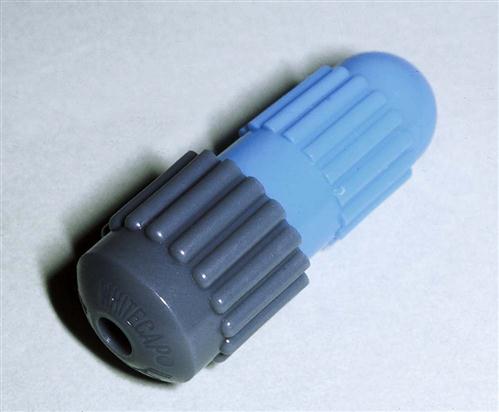
Trituration is the process by which the mercury and the alloy powder are mixed together to form the mass of amalgam needed to restore the tooth. The preloaded capsule of amalgam alloy and mercury contains a pestle, which aids in the mixing process. Before the capsule is placed in the amalgamator, many brands require the use of an activator, which breaks the separating membrane. The activated capsule is placed in the amalgamator, and the cover is closed to prevent mercury vapors from escaping during trituration. The amalgamator is set to operate for the length of time specified in the manufacturer’s directions. A proper mix should appear free of dry alloy particles and hold together as one unit.
Composite Resins
Composite resin is a tooth-colored dental material that is becoming the most widely used material by dentists, and the most requested by patients (Figure 20-3). Early in its use, this material had a composition that made it esthetically pleasing, but it was not able to withstand some of the properties discussed earlier in the chapter. Today, this tooth-colored material is able to (1) withstand the environments of the oral cavity; (2) be easily shaped to the anatomy of a tooth; (3) match the natural tooth color; and (4) be bonded directly to tooth surfaces for strength. The composition of composite resins include the resin matrix, inorganic fillers, and a coupling agent (Box 20-3).
Preparing the Composite Resin
Composite resins are supplied as a paste in lightproof syringes as well as capsules (Figure 20-4). This material is placed and adapted to the area of the tooth preparation. Once the application process has been completed, the material is polymerized (hardened) with the use of a curing light. The exact time of curing depends on the manufacturer’s instructions, the thickness of the material, the size of the restoration, and the shade of the material.
Cavity Liners
As their name implies, cavity liners are placed to line the deepest portion of the cavity preparation to provide pulpal protection or dentinal regeneration. The health of the tooth and the type of restorative material selected will determine what type of liner should be placed. The three most commonly placed types of liners are calcium hydroxide, dentin sealer, and cavity varnish.
Calcium Hydroxide
Calcium hydroxide is a frequently selected cavity liner because of its unique characteristics. It helps protect the pulp from chemical irritation, it has the ability to stimulate reparative dentin, and it is compatible with all types of restorative materials (Figure 20-5).
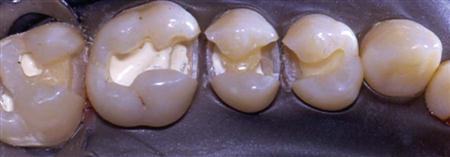
See Procedure 20-3: The Application of Calcium Hydroxide (Expanded Function).
Dentin Sealer
Dentin sealer, also referred to as a primer, is designed to seal the dentin tubules of the tooth, thus preventing oral fluids from seeping in between the tooth and the restoration, which could eventually cause hypersensitivity. Cavity varnish is being used less and less often with amalgam restorations, and dentin sealers are replacing cavity varnish as the liner of choice.
See Procedure 20-4: The Application of Dentin Sealer (Expanded Function).
Cavity Varnish
Cavity varnish is a liquid material placed throughout the cavity preparation to seal the dentinal tubules. It helps in reducing microleakage from saliva and fluids around the restoration, and acts as a barrier to protect the tooth from highly acidic cements, such as zinc phosphate. This material is contraindicated with composite resins and glass ionomer restorations because of interference with the materials bonding and setting properties.
See Procedure 20-5: The Application of Dental Varnish (Expanded Function).
Dental Bases
When a tooth preparation becomes moderately deep to deep, a base will be placed before placement of the final restoration. This additional layer helps to protect the pulp. A base can provide pulpal protection in three ways: as a protective base, as an insulating base, and as a sedative base.
Many of the dental cements that are discussed later in the chapter are utilized as a base by altering the measurements to the proper consistency.
Etching Systems
Acid etching, also referred to as a tooth conditioner is a technique applied to a prepared tooth surface before the use of many permanent restorative materials. This system was first designed for the preparation of enamel structure for composite materials and sealants, but research has found that etching a surface of enamel or dentin, the dental material will have better retention to the tooth surface.
The main ingredient of etching material is a phosphoric or maleic acid. This liquid or gel substance is applied to the enamel or dentin surface for a specified period of time to prepare the tooth for the bonding material.
See Procedure 20-6: Applying an Etchant Material (Expanded Function).
Bonding Systems
Bonding systems are liquid materials that flow into the etched surface of a tooth, creating micromechanical retention. This self-cured or light-cured material improves adherence between the tooth and the permanent restoration.
Enamel bonding allows the placement of sealants, orthodontic brackets, resin-bonded bridges, and bonded veneers. Dentin bonding allows the adhesion of another permanent material to the etched tooth structure. A major success associated with bonding to dentin is removal of the smear layer through the etching process. The smear layer is a thin layer of debris that is composed of fluids and tooth components that have remained on the dentin after cavity preparation and that need to be removed.
See Procedure 20-7: Applying a Bonding System (Expanded Function).
Temporary Restorative Materials
A temporary restoration is a short-term restoration that is placed for a short period of time. This type of restoration is selected instead of a permanent restoration (1) when the condition of the tooth may be questionable; (2) when the patient’s health may not permit more extensive dental treatment; and (3) for financial reasons.
The type of temporary restorative material selected depends on the location and amount of tooth structure that needs to be restored. The dental material most often used for a temporary restoration is intermediate restorative material, also referred to as IRM. IRM is a reinforced zinc oxide–eugenol material. The eugenol in this material has a sedative effect on the pulp, and fillers are added to improve the strength and durability of the material (Figure 20-6).
See Procedure 20-8: Mixing Intermediate Restorative Material (IRM).
Dental Cements
Dental cements represent a category of dental materials that are used routinely when working with indirect restorations (refer to Chapter 22 for types of casting). Depending on the dental procedure and the specific cement, three methods may be used for preparation of a cement product.
Mixing Dental Cements
Dental cements are mixed in a methodical manner. The differences include how the liquid and the powder are dispensed, as well as the ratios of liquid to powder. When learning a new material, make sure to
Stay updated, free dental videos. Join our Telegram channel

VIDEdental - Online dental courses


